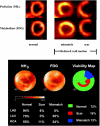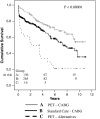Impact of preoperative positron emission tomography in patients with severely impaired LV-function undergoing surgical revascularization
- PMID: 20091350
- PMCID: PMC2852592
- DOI: 10.1007/s10554-010-9585-4
Impact of preoperative positron emission tomography in patients with severely impaired LV-function undergoing surgical revascularization
Abstract
In patients with ischemic cardiomyopathy, coronary artery bypass grafting (CABG) offers an important therapeutic option but is still associated with high perioperative mortality. Although previous studies suggest a benefit from revascularization for patients with defined viability by a non-invasive technique, the role of viability assessment to determine suitability for revascularization in patients with ischemic cardiomyopathy has not yet been defined. This study evaluates the hypothesis that the use of PET imaging in the decision-making process for CABG will improve postoperative patient survival. We reviewed 476 patients with ischemic cardiomyopathy (LV ejection fraction <or=0.35) who were considered candidates for CABG between 1994 and 2004 on the basis of clinical presentation and angiographic data. In a Standard Care Group, 298 patients underwent CABG. In a second PET-assisted management group of 178 patients, 152 patients underwent CABG (PET-CABG) and 26 patients were excluded from CABG because of lack of viability (PET-Alternatives). Primary endpoint was postoperative survival. There were two in hospital deaths in the PET-CABG (1.3%) and 30 (10.1%) in the Standard Care Group (P = 0.018). The survival rate after 1, 5 and 9.3 years was 92.0, 73.3 and 54.2% in the PET-CABG and 88.9, 62.2 and 35.5% in the Standard Care Group, respectively (P = 0.005). Cox-regression analysis revealed a significant influence on long-term survival of patient selection by viability assessment via PET (P = 0.008), of LV-function (P = 0.017), and age >70 (P = 0.016). Preoperative assessment of myocardial viability via PET identifies patients, who will benefit most from CABG.
Figures



Comment in
-
Positron emission tomography; viable tool in patients pre-CABG?Int J Cardiovasc Imaging. 2010 Aug;26(6):661-4. doi: 10.1007/s10554-010-9612-5. Epub 2010 Apr 1. Int J Cardiovasc Imaging. 2010. PMID: 20358291 Free PMC article. No abstract available.
Similar articles
-
Low dose wall motion score predicts the short and long-term benefit of surgical revascularization in patients with ischemic left ventricular dysfunction.Int J Cardiovasc Imaging. 2019 Sep;35(9):1651-1659. doi: 10.1007/s10554-019-01614-9. Epub 2019 May 3. Int J Cardiovasc Imaging. 2019. PMID: 31053980
-
Impact of left ventricular remodelling on outcomes after left ventriculoplasty for ischaemic cardiomyopathy: Japanese surgical ventricular reconstruction group experience.Interact Cardiovasc Thorac Surg. 2013 Jun;16(6):785-91. doi: 10.1093/icvts/ivt096. Epub 2013 Mar 8. Interact Cardiovasc Thorac Surg. 2013. PMID: 23475121 Free PMC article.
-
The amount of dysfunctional but viable myocardium predicts long-term survival in patients with ischemic cardiomyopathy and left ventricular dysfunction.Int J Cardiovasc Imaging. 2013 Oct;29(7):1645-53. doi: 10.1007/s10554-013-0254-2. Epub 2013 Jun 7. Int J Cardiovasc Imaging. 2013. PMID: 23744128
-
Myocardial Revascularization in Patients With Ischemic Cardiomyopathy: For Whom and How.J Am Heart Assoc. 2023 Mar 21;12(6):e026943. doi: 10.1161/JAHA.122.026943. Epub 2023 Mar 9. J Am Heart Assoc. 2023. PMID: 36892041 Free PMC article. Review.
-
The efficacy of revascularization in ischemic cardiomyopathy.Prog Cardiovasc Dis. 2025 Jan-Feb;88:105-112. doi: 10.1016/j.pcad.2024.12.007. Epub 2024 Dec 30. Prog Cardiovasc Dis. 2025. PMID: 39743125 Review.
Cited by
-
Positron emission tomography; viable tool in patients pre-CABG?Int J Cardiovasc Imaging. 2010 Aug;26(6):661-4. doi: 10.1007/s10554-010-9612-5. Epub 2010 Apr 1. Int J Cardiovasc Imaging. 2010. PMID: 20358291 Free PMC article. No abstract available.
-
Evaluating the prognostic value of positron-emission tomography myocardial perfusion imaging using automated software to calculate perfusion defect size.Clin Cardiol. 2012 Nov;35(11):E14-21. doi: 10.1002/clc.22058. Epub 2012 Sep 7. Clin Cardiol. 2012. PMID: 22961671 Free PMC article.
-
Cardiovascular imaging 2010 in the International Journal of Cardiovascular Imaging.Int J Cardiovasc Imaging. 2011 Mar;27(3):309-19. doi: 10.1007/s10554-011-9834-1. Epub 2011 Feb 24. Int J Cardiovasc Imaging. 2011. PMID: 21347592 Free PMC article. Review. No abstract available.
References
-
- ACC/AHA Guideline update for coronary artery bypass graft surgery. Circulation. 2004;110(14):e340–e437. - PubMed
-
- Appoo J, Norris C, Merali S, et al. Long-term outcome of isolated coronary artery bypass surgery in patients with severe left ventricular dysfunction. Circulation. 2004;110(11 suppl 1):11–13. - PubMed
Publication types
MeSH terms
LinkOut - more resources
Full Text Sources
Medical

